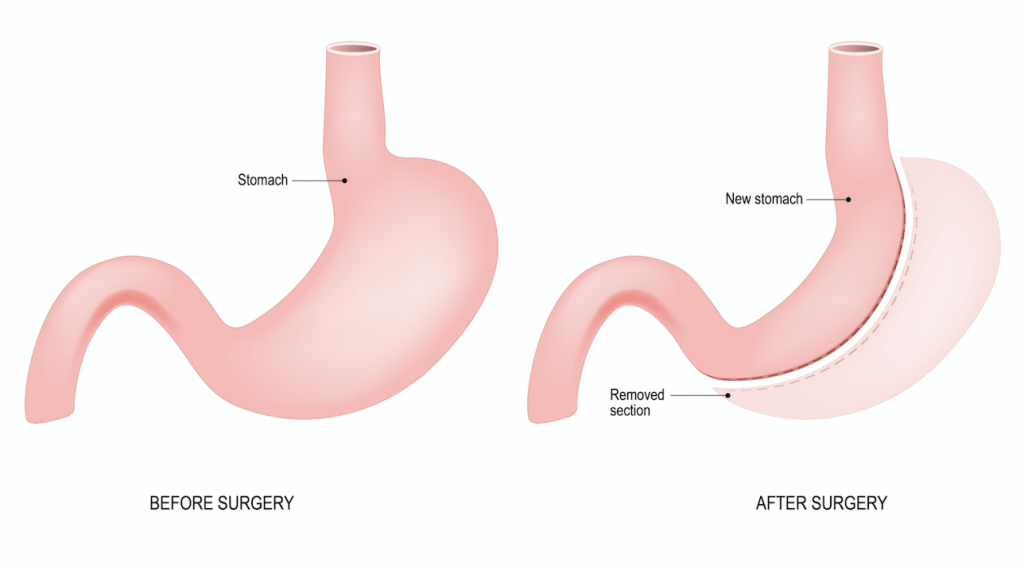
After months or years of trying to lose weight, the risks associated with obesity can start to take a toll on your body. For many people, bariatric surgery is the best and safest option to lose weight and keep it off. More than half of all bariatric surgeries performed in the US are gastric sleeve procedures.
Over the years, gastric sleeve surgery, also known as sleeve gastrectomy, a type of bariatric surgery, has become a popular choice among individuals considering weight loss surgery. Gastric sleeve surgery is one of the most common bariatric procedures due to its effectiveness and simplicity. Here are a few things you need to know before undergoing gastric sleeve surgery, and to help you find out if you might be a good candidate.
Introduction to Bariatric Surgery
Bariatric surgery, including gastric sleeve surgery, is a type of weight loss surgery designed to help individuals with obesity achieve significant weight loss and improve their overall health. Gastric sleeve surgery, also known as sleeve gastrectomy, is a popular bariatric surgery procedure that involves removing a large portion of the stomach, leaving a narrow, sleeve-like stomach. This reduction in stomach size limits the amount of food you can eat, helping you lose weight more effectively. By opting for gastric sleeve surgery, many individuals find it easier to manage their weight and reduce obesity-related health conditions.
What is gastric sleeve surgery?
Gastric sleeve surgery is a laparoscopic procedure that significantly reduces the size and alters the structure of your stomach to promote weight loss. The procedure is typically performed using laparoscopic surgery, which involves making small incisions in the upper belly. To qualify for this procedure, your body mass index (BMI) must be 40 or greater, or between 30 and 40 with other weight-related medical conditions.
During this procedure, your surgeon will create a small stomach “sleeve” by permanently removing 80-90% of your stomach, including the area containing the hunger hormone ghrelin, essentially causing your stomach to go from the shape of a football to the shape of a banana. These small incisions contribute to a faster recovery time and less post-operative discomfort. The decrease in stomach size and removal of the hunger hormone will cause you to feel less hungry and fill up more quickly, making it difficult to overeat and absorb excessive amounts of calories.
Comparison to Gastric Bypass Surgery
Gastric sleeve surgery is often compared to gastric bypass surgery, another well-known bariatric surgery procedure. While both surgeries aim to help individuals achieve significant weight loss, they differ in their approach. Gastric bypass surgery involves creating a small pouch from the stomach and connecting it directly to the small intestine, effectively bypassing a large portion of the stomach and small intestine. In contrast, gastric sleeve surgery involves removing a large portion of the stomach, leaving a narrow, sleeve-like stomach. This makes gastric sleeve surgery generally less invasive than gastric bypass surgery, often resulting in a faster recovery time and fewer long-term complications. For many, the simpler nature of the gastric sleeve surgery makes it an attractive option for weight loss.
What happens during a gastric sleeve procedure?
Before surgery, you will be given a general anesthesia to deeply sedate you and prevent you from feeling any pain during the procedure. Once you are asleep, your surgeon will create five small surgical openings in your abdomen and use a laparoscope, a thin tube with a camera on the end, to see inside your abdomen to perform the surgery.
Over the next 30-45 minutes, your surgeon will use small surgical instruments to divide and remove around two-thirds of your stomach. After, your stomach will resemble a long tube, joined together with a staple line, which is a critical part of the procedure.
Preparation and Eligibility
To be eligible for gastric sleeve surgery, individuals must meet specific criteria. Typically, candidates should have a body mass index (BMI) of 40 or higher, or a BMI of 35 or higher with obesity-related health conditions such as high blood pressure, diabetes, or sleep apnea. Beyond these criteria, candidates must be committed to making significant lifestyle changes, including adhering to a healthy diet and regular exercise habits. Additionally, attending regular follow-up appointments with healthcare providers is crucial for long-term success. Before surgery, individuals undergo a thorough evaluation, including a physical exam, laboratory tests, and a psychological assessment, to ensure they are suitable candidates for the procedure. This comprehensive preparation helps ensure the best possible outcomes for those undergoing gastric sleeve surgery.
What does a gastric sleeve diet look like?
After gastric sleeve surgery, you will be given a special diet plan to help you transition to eating with a smaller stomach. This plan begins with a clear liquid diet to help the stomach heal, and gradually incorporates solid foods.
You can expect to get most of your nutrition in the first few weeks after surgery from high-protein drinks. Once you have had more time to heal and adjust, you can begin incorporating pureed foods and eventually soft and regular foods.
Keep in mind that you will not be able to eat as much, so you will need to consciously choose foods that will help you maintain a healthy, balanced diet. Maintaining new eating habits is crucial for ensuring long-term weight loss success and preventing potential weight regain.
What are the benefits of the gastric sleeve compared to other weight loss surgeries?
Compared to other bariatric surgeries, such as gastric bypass and LAP-BAND, gastric sleeve surgery is a more straightforward procedure that typically takes less than an hour to complete. Gastric sleeve surgery is one of the most common bariatric surgery procedures due to its effectiveness and simplicity. The recovery process often goes well for many patients. Because a large portion of the stomach is removed and then stapled together, there is no need to re-route your intestines like with gastric bypass or insert a foreign body like with LAP-BAND surgery, which involves the use of a silicone device placed around the stomach. It is also typically a very affordable option for weight loss surgery.
What are some of the issues with a gastric sleeve?
With any weight loss surgery, there are risks and issues to consider. Because a large portion of the stomach is removed during gastric sleeve surgery, the procedure is not reversible. Complications can occur at the staple line, which is a critical part of the procedure. It is also not recommended for people with severe acid reflux disease, as it tends to be acid-inducing. There is also a possibility that the small stomach tube will stretch over time, which can lead to late weight gain.
In the long term, patients must adhere to a healthy diet and regular exercise to prevent weight regain. The stomach may widen over time, allowing for larger meals, which can contribute to weight regain if eating habits are not managed effectively.
The key takeaway
SCHEDULE AN APPOINTMENT TO SEE IF GASTRIC SLEEVE SURGERY IS RIGHT FOR YOU
Birmingham Minimally Invasive Surgery is a caring team of professionals specializing in all types of bariatric surgery. Our surgeon, Dr. Jay Long, has highly specialized training in bariatric surgery, having completed a fellowship in minimally invasive and bariatric surgery at The Methodist Hospital in Houston, Texas, where he focused on caring for patients who are morbidly obese. We are proud of our pricing, which we publish prominently on the front page of our website. Insurance won’t pay? We have a variety of financing options we can offer you so that you can get the healthy body you’ve wanted for years. Visit us today at www.bmisurgery.com or call us at 205-833-6907 to schedule a consultation.

